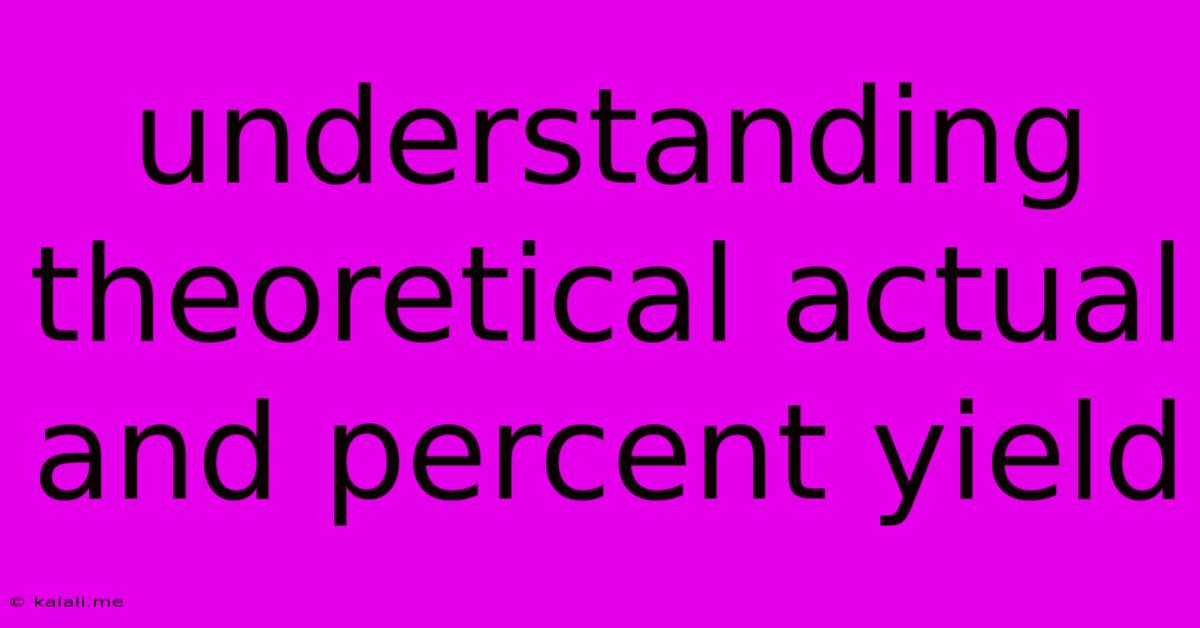Understanding Theoretical Actual And Percent Yield
Kalali
May 09, 2025 · 3 min read

Table of Contents
Understanding Theoretical, Actual, and Percent Yield: A Comprehensive Guide
Understanding theoretical, actual, and percent yield is crucial in chemistry, particularly for students and professionals working in laboratories. These terms are essential for evaluating the efficiency and success of chemical reactions. This guide will break down each concept, explain how to calculate them, and provide examples to solidify your understanding.
What is Yield? In simple terms, yield refers to the amount of product obtained from a chemical reaction. There are three key types of yield: theoretical, actual, and percent yield. Each provides a different perspective on the reaction's efficiency.
1. Theoretical Yield: The Ideal Outcome
Theoretical yield represents the maximum amount of product that could be formed in a chemical reaction, assuming complete conversion of the limiting reactant and no losses during the process. It's calculated based on the stoichiometry of the balanced chemical equation. This is the perfect scenario – a situation rarely achieved in practice due to factors like incomplete reactions, side reactions, and experimental losses.
Calculating Theoretical Yield:
To calculate theoretical yield, you need:
- A balanced chemical equation: This shows the molar ratios between reactants and products.
- The amount of limiting reactant: This is the reactant that is completely consumed first, determining the maximum amount of product that can be formed. You'll often need to perform a limiting reactant calculation first.
- Molar masses of reactants and products: These are needed to convert between moles and grams.
Example:
Let's say we're reacting 2 moles of hydrogen (H₂) with 1 mole of oxygen (O₂) to produce water (H₂O):
2H₂ + O₂ → 2H₂O
If we assume all 2 moles of hydrogen react completely, the stoichiometry tells us we should obtain 2 moles of water. Converting this to grams (using the molar mass of water, approximately 18 g/mol), we get a theoretical yield of 36 grams of water (2 moles * 18 g/mol = 36 g).
2. Actual Yield: The Reality of the Lab
Actual yield, on the other hand, represents the actual amount of product obtained in a chemical reaction. This is the mass of the purified product you isolate and measure in the laboratory after the reaction is complete. It's always less than or equal to the theoretical yield. The difference arises from various experimental limitations.
3. Percent Yield: A Measure of Efficiency
Percent yield is a crucial measure of the efficiency of a chemical reaction. It expresses the ratio of the actual yield to the theoretical yield, expressed as a percentage. A higher percent yield indicates a more efficient reaction, while a lower percent yield suggests losses or inefficiencies.
Calculating Percent Yield:
The formula for percent yield is:
Percent Yield = (Actual Yield / Theoretical Yield) x 100%
Example:
Continuing with the water example, let's say that after the reaction and purification, you actually obtained 30 grams of water. Using the theoretical yield of 36 grams calculated earlier:
Percent Yield = (30 g / 36 g) x 100% = 83.3%
This means the reaction had an 83.3% efficiency. The remaining 16.7% of the potential yield was lost due to various factors discussed below.
Factors Affecting Percent Yield
Several factors can influence the actual yield and consequently the percent yield of a reaction. These include:
- Incomplete reactions: Not all reactants may convert to products.
- Side reactions: Unwanted reactions may consume reactants, reducing the yield of the desired product. Purification steps are crucial to minimize this.
- Experimental losses: Some product may be lost during transfer, filtration, crystallization, or other purification steps.
- Equilibrium limitations: Some reactions reach an equilibrium state before all reactants are consumed.
- Impurities in reactants: Impurities in the starting materials can interfere with the reaction.
Understanding theoretical, actual, and percent yield is not just an academic exercise; it is vital for optimizing chemical processes, improving product purity, and making accurate assessments of reaction efficiency in industrial and research settings. By carefully considering the factors influencing yield, chemists strive to maximize the efficiency and productivity of their work.
Latest Posts
Latest Posts
-
Is Miranda Cosgrove Related To Jimmy Fallon
Jul 03, 2025
-
What Is 1 4 Of A 1 4 Cup
Jul 03, 2025
-
What Is 20 Percent Off Of 39 99
Jul 03, 2025
-
Where Is The 3 In Riddle Transfer
Jul 03, 2025
-
How Much Does A Water Bottle Weight
Jul 03, 2025
Related Post
Thank you for visiting our website which covers about Understanding Theoretical Actual And Percent Yield . We hope the information provided has been useful to you. Feel free to contact us if you have any questions or need further assistance. See you next time and don't miss to bookmark.